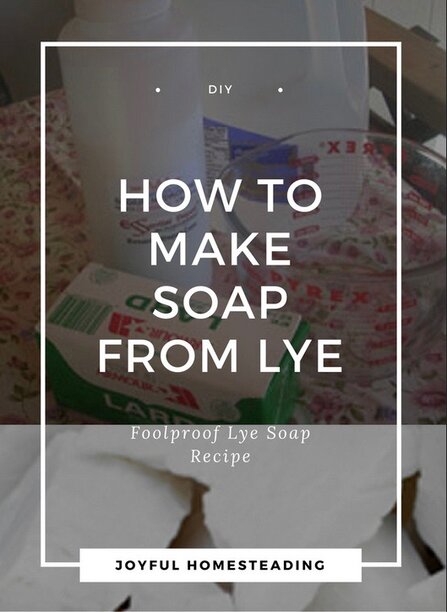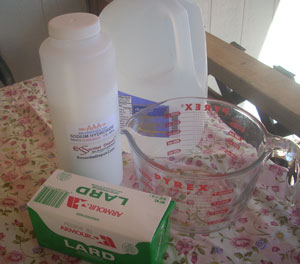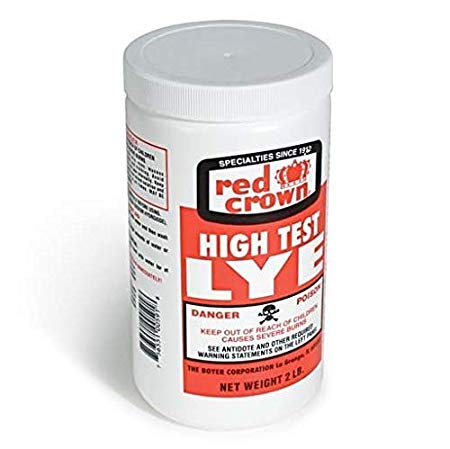Lye Soap Recipe
Using this lye soap recipe is a good way to learn the ropes of soapmaking in a very simple, basic way. Unlike the trickier oils, lard works great in a soap recipe and sets up virtually every time. This recipe has never failed me.

By the way, while you shouldn't be intimidated with using lye, you should be cautious.
Always place the lye in a stainless steel container used specifically for the purpose or a glass measuring cup before adding the water and always wear rubber gloves when working with lye. Do this in a well-ventilated area, preferably near an open window.
You won't be able to find lye in most grocery stores, but you can find it here.
This lye soap recipe makes about 20 good sized bars, enough to last you for a few months. It's made with lard and lye and is a basic white soap recipe that couldn't be simpler.
Here are the ingredients you will need for this simple soap recipe. To learn about the history of making lye soap, click here to see part one.
Lye Soap Recipe
The Ingredients

Here are the items you will need for this lye soap recipe:
- 2 spoons, either plastic or stainless steel
- 1 2-quart stainless steel saucepan or a large glass measuring cup - use this to mix the lye
- 1 large stainless steel pot - use this to melt the fat
- 1 plastic spatula
- 1 plastic ladle
- 1 paring knife
- 1 scale
- Plastic wrap and newspaper to cover your working area
- Glass candy thermometer - crucial for accurate temperature control
- A mold - this can be as simple as a cardboard box lined with plastic
- Spray-on corn oil, mineral oil or petroleum jelly
By the way: Never make this handmade soap recipe in aluminum containers. If you do, both the container and the soap will be ruined. Also, don't use a wooden spoon; eventually the lye will eat away at the fibers in it.
If You Have Hard Water
If you use hard water in your soap recipe, your soap will not lather as well. If you don't have access to soft water, add one ounce of borax to your soap recipe, or save rainwater for your soap recipes.
Easy, Basic Soap Recipe
This recipe comes from the book, Milk-based soaps by Casey Makela, an excellent resource if you want to find some unique handmade soap recipes in addition to a good lye soap recipe.
- 6 pounds of rendered animal fat or lard.
- 4 1/2 cups of cold, soft water - either rainwater or from a water softener
- 12 ounces pure lye
Heat the Fat
Heat the fat in an 8-quart stainless steel pot on low heat until it has melted and has reached the temperature of 110 degrees Fahrenheit or 43 degree Celsius, using a glass thermometer to measure the temperature.
Prepare the Lye
While melting the fats, pour four and a half cups of soft water into the stainless steel saucepan. Carefully add the lye to the water, stirring gently with a plastic spoon. Be careful not to inhale the fumes. Set the mixture aside to cool to 85 degrees.
Mix Them Together
Make sure the fat is 110 degrees Fahrenheit, and the lye-water mixture is 85 degrees Fahrenheit. Then slowly pour the lye and water into the fat, stirring constantly. You want to pour the lye and water slowly into the fat. That keeps it from splashing and also helps it to mix better.
Continue stirring for at least 30 minutes to one hour. The mixture will begin to thicken and resemble a thin pudding. When your spoon feels like it can stand on its own and a few drops leave a pattern on the surface of the soap, pour the mixture into the mold. Set it aside in a draft-free area for 24 to 48 hours.
It will take up to two days for the entire mixture to convert into soap. After 24 hours, check your soap. When you can easily make a dent in the soap by pressing firmly with your finger, the soap is ready to cut. Don't wait until your soap is too hard or it will be impossible to cut.
When your cut bars are hard enough, remove them from the mold and allow them to cure for six weeks before using them.











New! Comments
Have your say about what you just read! Leave me a comment in the box below.